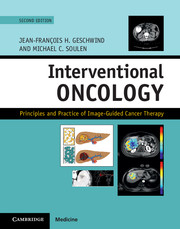Book contents
- Frontmatter
- Contents
- List of contributors
- Section I Principles of oncology
- Section II Principles of image-guided therapies
- Section III Organ-specific cancers – primary liver cancers
- Section IV Organ-specific cancers – liver metastases
- Section V Organ-specific cancers – extrahepatic biliary cancer
- Section VI Organ-specific cancers – renal cell carcinoma
- Section VII Organ-specific cancers – chest
- 24 Image-guided ablation in the thorax
- Section VIII Organ-specific cancers – musculoskeletal
- Section IX Organ-specific cancers – prostate
- Section X Specialized interventional techniques in cancer care
- Index
- References
24 - Image-guided ablation in the thorax
from Section VII - Organ-specific cancers – chest
Published online by Cambridge University Press: 05 September 2016
- Frontmatter
- Contents
- List of contributors
- Section I Principles of oncology
- Section II Principles of image-guided therapies
- Section III Organ-specific cancers – primary liver cancers
- Section IV Organ-specific cancers – liver metastases
- Section V Organ-specific cancers – extrahepatic biliary cancer
- Section VI Organ-specific cancers – renal cell carcinoma
- Section VII Organ-specific cancers – chest
- 24 Image-guided ablation in the thorax
- Section VIII Organ-specific cancers – musculoskeletal
- Section IX Organ-specific cancers – prostate
- Section X Specialized interventional techniques in cancer care
- Index
- References
Summary
Surgical resection remains the reference standard for the treatment of early-stage lung cancer and isolated pulmonary metastases in select patients. Although surgery offers patients the best chance of disease-free survival, only about a third of patients with non-small cell lung cancer (NSCLC) are considered candidates for surgical resection. Historically, these patients have been treated with chemotherapy or external-beam therapy; however, these modalities provide only modest improvements in overall survival. Over the past decade, several new minimally invasive therapies, such as thermal ablation, stereotactic body radiotherapy, and targeted receptor inhibitors, have emerged as promising treatment alternatives for non-operative candidates.
Thermal ablation is an exciting and cost-effective therapy that offers patients an effective and safe treatment to palliate and, in some cases, cure both primary and metastatic thoracic malignancies. The benefits of thermal ablation include that it can be repeated, used in previously irradiated fields, and used in conjunction with pharmacologic treatments, chemotherapy, or radiotherapy.
The goal of this chapter is to discuss and review the technologies and techniques available for tumor ablation of thoracic malignancies, including the basic physics of ablation, procedure technique, imaging follow-up, comparisons between therapies, and applications and outcomes for ablation therapy in the thorax.
Physics of ablation therapy
Image-guided tumor ablation utilizes thermal or electrical energy to create controlled destruction of cells and tissues. The three mainstays in thermal ablation therapy, radiofrequency ablation (RFA), microwave ablation (MWA), and cryoablation (CA), are discussed in this chapter. Additionally, irreversible electroporation (IRE), the newest ablation modality, is reviewed in this piece.
Radiofrequency ablation
In RFA, an alternating current about the frequency of radio waves (460–480 kHz) is created between an electrode and grounding pads placed on the patient. The insulated electrode has a conducting tip that creates ion agitation in adjacent tissue, as electrons move toward the reference electrodes (grounding pads). This friction is converted to heat, leading to thermal injury and cell death in a controlled manner. The goal of RFA is to achieve temperatures between 60°C and 100°C, which allow for near-instantaneous protein coagulation, damage to cytosolic and mitochondrial enzymes, and damage to DNA–histone complexes.
- Type
- Chapter
- Information
- Interventional OncologyPrinciples and Practice of Image-Guided Cancer Therapy, pp. 223 - 242Publisher: Cambridge University PressPrint publication year: 2016
References
- 1
- Cited by



